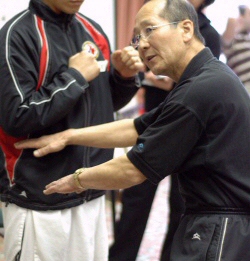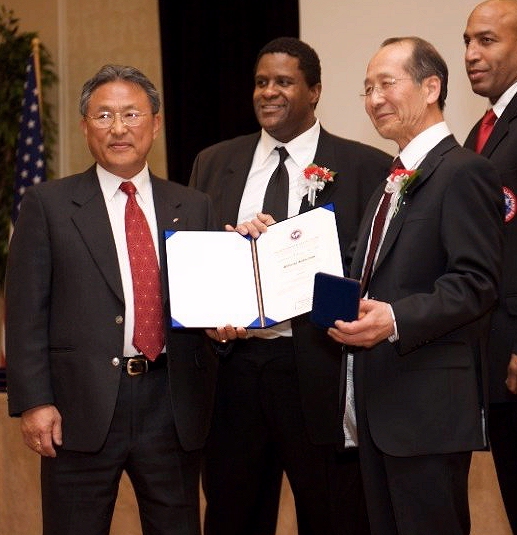Coaching Perspective: Grandmaster Chong Lee
April 10th, 2009 by Alex Frakking
|

GM Chong Lee presents a concept at a
coaching seminar
|
Grandmaster Chong Lee (9th Dan) Introduced Taekwondo to Canada in
1964.
Since that time he has trained over 300,000 students and has produced nearly
two
hundred gold medals in Canadian National Taekwondo Championships, has coached
the national team for over forty years, and has been the Coaching Chairman
for
Taekwondo Canada. During an interview in 2008, G.M. Chong Lee discussed
several aspects of athlete development and combat strategy.
In the past few years, Canadian athletes have produced many international
medals and
Olympic medals, however many coaches can still further improve in the areas
of yearly
planning and physical conditioning such as how to apply strength building
during
preparation phase, and how to convert gained strength into power during specific
preparation phase.
So many talented Canadian athletes try hard but are not able to win because
they only
focus on repetition of techniques day after day. If all the coaches apply
strength training
and how to convert strength into power, they will have more chance to reach
their
objectives. I recommend light weight training for beginners with moderate
speed of
execution and proper techniques of how to squeeze muscle fibres. However
for athletes
who are familiar with heavy weight training, I recommend that 1RM (one-rep
max)
power training could benefit them greatly, and enhance their nerve system
to employ
more muscle fibres (fast-twitch muscles) throughout execution.
Hypertrophy belongs to some particular sports such as weight lifting, but
sports which
require explosive power do not need large bulky muscles; rather they need
lean muscles
which are able to contract fast-twitch muscles effectively. Isotonic exercise
and plyometric
power training are most efficient ways to convert gained strength into power,
and ballistic
power training can develop accelerated power and speed. However, while doing
weight
training you have to build the whole body. When building quad, you have to
build ham.
If you build only one side of muscles, you will fail to achieve the full
potential of the
techniques.
Also the three energy systems are frequently not given enough consideration.
These three
systems (anaerobic alactic, anaerobic lactic, and aerobic) reconstitute the
ATP/CP which
is the primary energy for acceleration/speed. Before building a house, you
must put down
a foundation. Don’t forget that aerobic endurance exercises are your
foundation; if you are
not prepared for aerobic endurance training, you cannot apply the max-anaerobic
system.
If other words, if your foundation is weak, your house will fall. However,
during anaerobic
training when your athletes are near anaerobic threshold, to avoid going
beyond threshold,
athletes must learn to adjust work-effort during the training
session.

GM Chong Lee coaches Evangelos
Ligeros at the 2004 Pan American
Championships (Dominican Republic) |
It is common that athletes are in well-prepared condition physiologically,
but fail to prepare
mentally and psychologically. They have not learned to put themselves in
their comfort zone,
in which they control their activation level to the right degree during
competition. This is often
more important than physiological preparation. Optimum psychological performance
has
become key for success in combat. I strongly recommend that athletes participate
in many
competitions as each experience will bring more tactical strategy, such as
read and react
(reflection skill), eye sharpness to analyze opponents and detect
opponents’ weaknesses,
development of mental domination, and how to break the opponents’ spirit.
Mental strategy
does not fall from trees; you have to prepare through yearly preparation
and through combat
experiences.
Athlete and coach are like horse and jockey; the horse knows how to run and
the jockey
knows how to manoeuvre. Those two combined have more chance to win. They
are a team;
they have to learn to trust each other when the fight is on. The coach and
athlete should be
connected and “present” in the very moment. It is a time for them
to taste the fruit they have
cultivated previously. If a horse decides to go his or her own way and the
jockey forces going
to the other side, it is a lost race. Both have to bring their spirit in
tandem.
Source:
CombatCanada.ca
|
